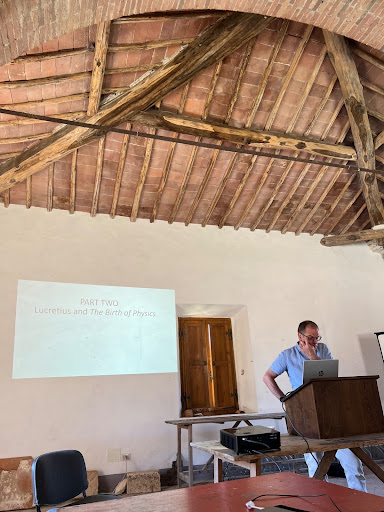On Michel Serres’s The Birth of Physics: a Lecture by Dr. David Webb
May 3, 2023
By Rummy Gill, Cohort ’20
During the 2022 summer residency at Spannocchia Castle in Tuscany, IDSVA students and faculty members, Dr. Simonetta Moro, Dr. Dejan Lukic, and Dr. Jason Hoelscher, engaged with visiting guest Dr. David Webb, Professor of Philosophy from Staffordshire University in the UK. Webb’s two-day lecture on Michel Serres and his book The Birth of Physics, a commentary on ancient physics and the rebirth of philosophical interests in the ancients, unfolded alongside a reading of Lucretius’ poem De Rerum Natura or “On the Nature of Things” (Serres, BoP, 1). For Serres, The Birth of Physics serves as a “kinship” to recovering the Lucretian ancient atomism as a “creative relationship between philosophy and science” (Serres 2). Here as we sit on top of a Tuscan hill, at Spannocchia, Serres would say, is an order of things, it is local, made up of its own “layers, levels, scales” (Serres, BoP, 79). It makes one wonder how many atoms collided to combine and metamorphosize this place of beauty. It is hard not to reflect on whether Spannocchia is still the same place as when it first emerged.

The air is hot, thick, and fragrant at Spannocchia. In the classroom, the buzzing flies swerve above our heads as we reflect on the translucent atoms, their profundities, and possibilities. According to Webb, for Serres, it is that “minimal angle of deviation from a laminar flow” where the tumultuous and muddled atoms ascend as the “turbo” – what Serres called “the spiral, vortex or spinning cone” as being a “quasi-stable” condition where patterns of repetition and regularity occur, making things happen; it is in this moment that new order is being created (Serres, BoP, 5). In ancient physics, it is this attention to “turbulence and the rocking motion of floating bodies” that differs from “solid bodies on stable paths” that is situated in modern physics (Serres 5). For Serres, it is within this necessity that possibilities of variations in the universal system open up as forms of transformation and creativity. As Webb pointed out, in Serres’s thinking there is “no dominance, just a variance” which “includes everything, everything is all of its relations and all of its experience” (Webb, lecture). For Serres, it is in the vitality of the multiple that “the world is a multiplicity of flows, each inclined in relation to the other within its stability as being the ‘order of things" (lecture).
One can say Spannocchia is simply one vortex within the vortices of the world interlacing as “a maze of waves” in a quasi-stable way (Serres, BoP, 71). Serres would say Spannocchia has its own variation – growing, changing, unstable, “not being determined by the same laws” (Serres, BoP 71). As Webb explained, “The vortex is the characteristic of everything for Lucretius, it is the pattern of free will [ . . . ]there are different worlds within the universe and thus order will be determined differently according to its regularity, geography, and its time and space” (Webb, lecture). In the end, “it is building a patchwork of all different patterns which are overlaid rather than leveling them out” which was important for Serres, and it is “the sum of these cords, stitches, and knots, assembled in various latticework, interconnected throughout, that defines nature” (Serres, Natural, 111). Webb describes causality as preceding law through multiple linkages, rather than in a linear manner.
Instead of invoking laws, “we trace histories, connecting the local to the local, building the global, working towards a different universal” (lecture). In many ways, the arrangements, alterations, and impermanence of the Lucretian atoms are engaging us in relation to nature and reminding us of the fragility of the world rather than safeguarding law as a regulator over and above nature (Serres, BoP, 11). “What, once again, is physics? It is the science of relations. Of relations in general between atoms of various families” (Serres 148). For Serres’s thinking, it is the Lucretian atomism’s spatiality and temporality that is of importance as it holds the space open with no originary, no radical principle, offering only variations within an infinite universe.

As Webb’s lecture comes to a close, the Tuscan sun rays dance in their own variations inside the classroom, making us reflect on Serres’s thinking – is Webb saying that Serres’s Birth of Physics is an alliance with Lucretius’ thinking or not? As he put it, “perhaps, that’s one way of looking at it, but it’s not the only way to read him” (Webb, lecture). He continued, “Serres’s thinking did not situate into an overarching category, discipline, or any specific philosophical concept” (lecture). According to Serres, it is the path that leads off onto other routes” then perhaps, it is more global in many ways (lecture). I suppose one can say, Serres is shifting away from reductionist sensibilities in order to go beyond boundaries where one engages, combines, and ultimately enriches the multiplicities of the universe. Like Lucretius’ atomism, in Serres’ thinking, there is “no place to rest,” “it’s endless” with “no limit opening wide in all directions'' in the hope of variant possibilities (Lucretius II: 89-93).

Works Cited
Lucretius, The Nature of Things. Trans. A.E. Stallings. Penguin Books, London, 2007.
Serres, Michel. Natural Contract. Trans. Elizabeth MacArthur and William Paulson. University of Michigan Press, 1995.
Serres, Michel. The Birth of Physics. Trans. David Webb and William Ross. Rowman & Littlefield, London and New York, 2018.
Webb, David. Lecture on The Birth of Physics, Spannocchia Castle, Tuscany, Italy. June, 2022.
